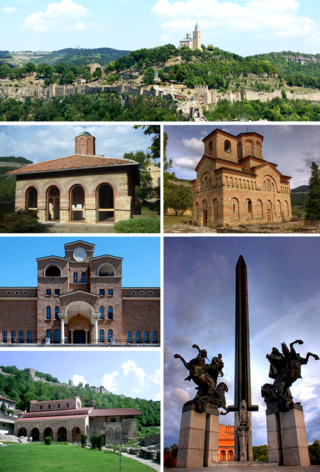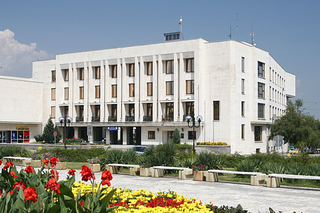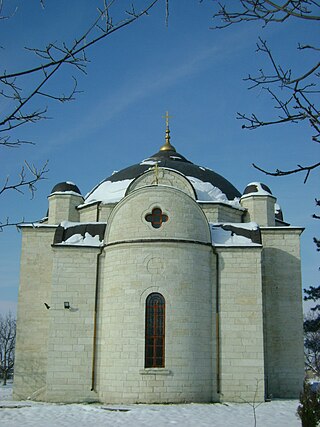Related Research Articles

Veliko Tarnovo is a city in north central Bulgaria and the administrative centre of Veliko Tarnovo Province. It is the historical and cultural capital of Bulgaria.
Novo Selo, meaning "new village" in several Slavic languages, may refer to the following places:

Gorna Oryahovitsa is a town in northern Bulgaria, situated in Veliko Tarnovo Province, 10 km (6 mi) from Veliko Tarnovo. It is the administrative centre of the homonymous Gorna Oryahovitsa Municipality. According to the 2021 Census, the town has a population of 27,317 inhabitants.

Arbanasi is a village in Veliko Tarnovo Municipality, Veliko Tarnovo Province of central northern Bulgaria, set on a high plateau between the larger towns of Veliko Tarnovo and Gorna Oryahovitsa. It is known for the rich history and large number of historical monuments, such as 17th- and 18th-century churches and examples of Bulgarian National Revival architecture, which have turned it into a popular tourist destination.
The linguistic classification of the ancient Thracian language has long been a matter of contention and uncertainty, and there are widely varying hypotheses regarding its position among other Paleo-Balkan languages. It is not contested, however, that the Thracian languages were Indo-European languages which had acquired satem characteristics by the time they are attested.

United Bulgarian Bank (UBB) is one of the leading Bulgarian commercial banks. It is the first and largest banking consolidation project in Bulgaria, accomplished through the merger of 22 state-owned commercial banks throughout the country. UBB was established on 30 September 1992. The Bank manages assets, worth approximately BGN 6.6 billion and renders services to its clients via nearly 200 branches and banking structures throughout the country. The core business of UBB is being supported through the activity of its subsidiaries, UBB Asset Management, UBB Factoring and UBB Insurance Broker.

The Bulgarian name system has considerable similarities with most other European name systems, and with those of other Slavic peoples such as the Russian name system, although it has certain unique features.

The 28 provinces of Bulgaria are divided into 265 municipalities. Municipalities typically comprise multiple towns, villages and settlements and are governed by a mayor who is elected by popular majority vote for a four-year term, and a municipal council which is elected using proportional representation for a four-year term. The creation of new municipalities requires that they must be created in a territory with a population of at least 6,000 and created around a designated settlement. They must also be named after the settlement that serves as the territory's administrative center, among other criteria.

The modern history of beer in Bulgaria dates back to the 19th century, when it was introduced to the country by foreigners shortly before the Liberation of Bulgaria. Until then, beer was practically unknown in what used to be a mainly rakia and wine-drinking country. Today, Bulgaria ranks 15th by beer consumption per capita, with 73 litres a year.

European route E85 is part of the International E-road network, which is a series of main roads in Europe.

Uzundzhovo is a village in southeastern Bulgaria, part of Haskovo municipality, Haskovo Province. As of 2008, it has a population of 1,727 and the mayor is Vancho Vanchev. The village lies in the agricultural Upper Thracian Plain, east of Haskovo, south of Dimitrovgrad and west of Simeonovgrad and Harmanli. During Ottoman rule, the village was known as Uzunca ova, a direct translation of the area's former Byzantine Greek appellation, Makri livada. The village's current name is derived from the Ottoman Turkish name and modified with the Slavic placename suffix -ovo. An architectural reminder of the village's Ottoman history can also be seen, as the local Church of the Assumption was built originally as a mosque. Uzundzhovo hosts the Bulgarian Air Force's 21st Fighter and Bomber Airbase, shut down in 1998.
Dolna Oryahovitsa is a town in northern Bulgaria, part of Gorna Oryahovitsa municipality, Veliko Tarnovo Province.

Elena Municipality is a municipality (obshtina) in Veliko Tarnovo Province, Central-North Bulgaria, located on the northern slopes of the central Stara planina mountain in the area of the so-called Fore-Balkan. It is named after its administrative centre, the town of Elena. It includes a territory of 671.39 km2 (259.23 sq mi) with a population of 10,407 inhabitants, as of December 2009.
This is a list of people, places, and events related to the medieval Bulgarian Empires — the First Bulgarian Empire (681–1018), and the Second Bulgarian Empire (1185–1396).
Polski Senovets is a village in Veliko Tarnovo Province, north-central Bulgaria.
The 2014–15 V Football Group season was the 65th season of the Bulgarian V Group. The group comprises the third level of the Bulgarian football pyramid and is divided into four geographic regions:North-West, North-East, South-East, and South-West.

Rahovets was an ancient Thracian, medieval and Ottoman fortress in Northeastern Bulgaria. It is located on a hill close to the town of Gorna Oryahovitsa (2 km) and Veliko Tarnovo (5 km).
Romylos of Vidin, also known as Romylos of Ravanica or Romylus the Athonite, was a 14th-century Bulgarian monk, a disciple of Gregory of Sinai. He is also known as the teacher of Grigorije of Gornjak. He is regarded as part of both Bulgarian and Serbian literature.
References
- Чолева-Димитрова, Анна М. (2002). Селищни имена от Югозападна България: Изследване. Речник (in Bulgarian). София: Пенсофт. ISBN 954-642-168-5. OCLC 57603720.